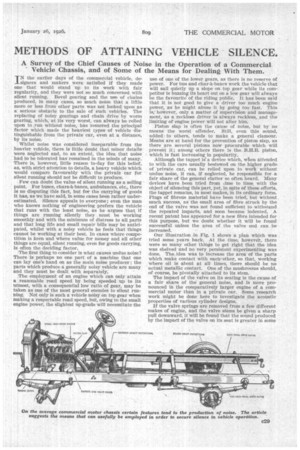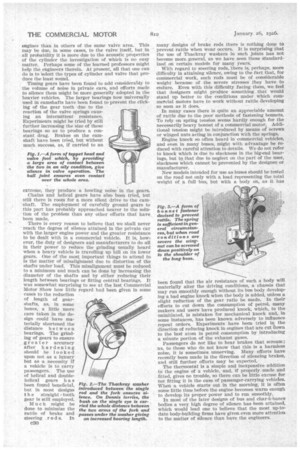METHODS OF ATTAINING VEHICLE SILENCE.
Page 13

Page 14

If you've noticed an error in this article please click here to report it so we can fix it.
A Survey of the Chief Causes of Noise in the Operation of a Commercial Vehicle Chassis, and of Some of the Means for Dealing With Them.
IN the earlier days of the commercial vehicle, designers and makers were satisfied if they made one that would stand up to its work with fair regularity, and they were not so much concerned. with silent running. Bevel gearing and the use of chains produced, in many cases, so much noise that a little more or less from other parts was not looked upon as a serious obstacle to the sale of such vehicles. The replacing of noisy gearings and chain drive by worm gearing, which, at its very worst, can always be relied upon to ,run without noise, has removed the principal factor which made the heaviest types of vehicle distinguishable from the private car, even at a distance, by its noise.
-Whilst noise was considered inseparable from the heavier vehicle, there is little doubt that minor details were neglected and, to an extent, the idea that noise had to be tolerated has remained in the minds of many. There is, however, little reason to-day for this belief, as, with strict attention to details, a heavy vehicle which would compare favourably with the private car for silent running should not be difficult to produce.
Few can doubt the value of silent running as a selling point. For buses, chars-h-banes, ambulances, etc., there is no disputing this fact, but for the carrying of goods it has, as we have said, in some cases been rather underestimated. Silence appeals to everyone; even the man who knows nothing of engineering prefers the vehicle that runs with the least noise, as he argues that if things are running silently they must be working smoothly and with the minimum of distress to all parts and that long life and small repair bills may be anticipated, whilst with a noisy vehicle he feels that things cannot be working at their best. In cases where competition is keen and where value for money and all other things are equal, silent running, even for goods carrying, is often the deciding factor.
The first thing to consider is what causes undue noise? There is perhaps no one part of a machine that one can lay one's hand on as the main noise producer ; the parts which produce a generally noisy vehicle are many and they must be dealt with separately.
The employment of an engine which can only attain a reasonable road speed by being speeded up to its utmost, with a consequential low ratio of gear, may be taken as one of the most general enemies to silent running. Not only is such a vehicle noisy on top gear when making a respectable road speed, but, owing to the small engine power, the slightest up-grade will necessitate the use of one of the lower gears, as there is no reserve of power. For bus and char-h-banes work the vehicle that will sail quietly up a slope on top gear while its competitor is buzzing its heart out on a low gear will always be the favourite' of the riding public. It has been said that it is not good to give a driver too much engine power, as he might abuse it by going too fast.. This is,' however, only a matter of supervision and management, as a reckless driver is always reckless, and the limiting of engine power will not alter him.
Piston slap is often the cause of noise, but by no means the worst offender. Still, even this sound, added to others, tends to make a general clamour. Means are at hand for the prevention of piston slap, as there are several pistons now procurable which will prevent it ; among others there is the B.H.B. piston, which is fast increasing in popularity.
Although the tappet is' a device which, when attended to with the care usually bestowed on the higher grade of private car, can be relied upon to work without undue noise, it can, if neglected, be responsible for a fair share of the general clatter so often heard. Many devices have been tried from chne to time with the object of silencing this part, yet, in spite of these efforts, the tappet remains, in most makes, in its ordinary form. Plugs of fibrous material have been tried, but without much success, as the small area of fibre struck by the end of the valve was not found sufficient to withstand the repeated impacts, and soon became indented. A recent patent has appeared for a new fibre intended for this purpose, but we doubt whether it will be found successful unless the area of the valve end can be increaSed.
Our illustration in Fig. 1 shows a plan which was tried some years back. At the time, however, there were so many other things to get right that the idea was shelved and no very persistent experimenting was done. The idea was to increase the area of the parts which make contact with each other, so that, working where oil is about at all times, there should be no actual metallic contact. One of the mushrooms should, of course, be pivotally attached to its stem.
The impact of the valve on its seating is the cause of a fair share of the general noise, and is more pronounced in the comparatively larger engine of a commercial motor than in a private car. Some research work might be done here to investigate the acoustic properties of various cylinder designs.
If the valve springs are removed from a few different makes of engine, and the valve stems be given a sharp pull downward, it will be found that the sound produced by the impact of the valve on its seat is greater in some engines than in others of the same valve area. This may be due, in some cases, to the valve itself, but in all probability it is more due to the acoustic properties of the cylinder the investigation of which is no easy matter. Perhaps some of the learned professors might help the engineers therein. At present, all that one can do is to Select the types of cylinder and valve that produce the least sound.
Timing gears have been found to add considerably to the volume of noise in private cars, and efforts made to silence them might be more generally adopted in the heavier vehicles. The larger bearings now universally used in camshafts have been found to prevent the clicking of the gear teeth due to the reaction of the valve springs causing an intermittent resistance. Experiments might be tried by still further increasing the size of these bearings so as to produce a constant drag. Brakes on the camshaft have been tried, but without much success, as, if carried to an Fig. 1.—A form of tappet head and valve foot which, by providing a large area of contact between the two in an oily cOndition, give silence in valve operation. The ball joint ensures even contact over the whole area.
extreme, they produce a howling noise inthe gears. Chains and helical gears have also been tried, but still there is room for a more silent drive to the camshaft, The employment of carefully ground gears to this part has probably approached nearer to the solution of the problem than any other efforts that have been made.
M u c Ii might be done to minimize the rattle of brake and steering r o d s. In 030 many designs of brake rods there is nothing done to prevent rattle when wear occurs. It is surprising that the use of Thackray washers in such joints has not become more general, as we have seen these standardized on certain models for many years.
With regard to steering rods, 'there is, perhaps, more difficulty in attaining silence, owing to the fact that, for conimercial work, such rods must be of considerable weight' because of the severe stresses they have to endure. Even with this difficulty facing them, we feel that designers might produce something that would stand up better to the conditions under which commercial motors have to work without rattle developing so soon as it does.
In many cases there is quite an appreciable amount of rattle due to the poor methods of fastening bonnets. To rely on spring tension seems hardly enough for the necessarily heavy bonnet of a commercial motor, Additional tension might be introduced by means of screws or winged nuts acting in conjunction with the springs.
Engine knock so often heard in commercial vehicles, and even in many buses, might with advantage be reduced with careful attention to details. We do not refer to knock which is due to slackness in the big-end bearings, but to that due to neglect on the part of the user, slackness which cannot be prevented by the designer or manufacturer.
New models intended for use as buses should be tested on the road not only with a load representing the total weight of .a full bus, but with a body on, as it has
been found that the air resistant* of such a body will materially alter the driving conditions, a• chassis that may run smoothly enough without its bus body developing a bad engine knock when the body is added, unless a slight reduction of the gear ratio be made. In their efforts to cut down the consumption of petrol, many makers and users have produced knock, which, to the uninitiated, is mistaken for mechanical knock and, in some instances, has been known adversely to influence repeat orders. Experiments have been tried in the direction of reducing knock in engines that are cut down to the last atom in petrol consumption by introducing a minute portion of the exhaust gases. Passengers do not like to hear brakes that scream; 'as, to those who do not know that this is a harmless noise, it is sometimes unnerving. Many efforts have recently been made in the direction of silencing brakes, and still further efforts may be expected.
The thermostat is a simple and inexpensive addition to the engine of a vehicle, and, if properly made and fitted, gives no trouble, so there can be little excuse for not fitting it in the case of passenger-carrying vehicles. When a vehicle starts out in the morning, it is often some little time before the engine becomes warm enough to develop its proper power and to run smoothly.
In most of the later designs of bus and char-A-banes bodies a very high degree of silence has been attained, which would lead one to believe that the most up-todate body-building firms have given even more attention to the matter of silence than have the engineers.




























